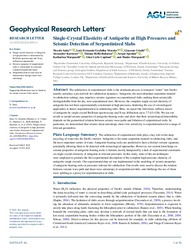Single‐Crystal Elasticity of Antigorite at High Pressures and Seismic Detection of Serpentinized Slabs
DOI: https://doi.org/10.1029/2022GL099411
Persistent URL: http://resolver.sub.uni-goettingen.de/purl?gldocs-11858/10355
Persistent URL: http://resolver.sub.uni-goettingen.de/purl?gldocs-11858/10355
Supplement: https://doi.org/10.6084/m9.figshare.20348748, https://doi.org/10.6084/m9.figshare.20348781
Satta, Niccolò; Grafulha Morales, Luiz Fernando; Criniti, Giacomo; Kurnosov, Alexander; Boffa Ballaran, Tiziana; Speziale, Sergio; Marquardt, Katharina; Capitani, Gian Carlo; Marquardt, Hauke, 2022: Single‐Crystal Elasticity of Antigorite at High Pressures and Seismic Detection of Serpentinized Slabs. In: Geophysical Research Letters, Band 49, 16, DOI: 10.1029/2022GL099411.
 |
Dokument öffnen: |
The subduction of serpentinized slabs is the dominant process to transport “water” into Earth's mantle, and plays a pivotal role for subduction dynamics. Antigorite, the most abundant serpentine mineral in subduction settings, may imprint a seismic signature on serpentinized slabs, making them seismically distinguishable from the dry, non‐serpentinized ones. However, the complete single‐crystal elasticity of antigorite has not been experimentally constrained at high pressures, hindering the use of seismological approaches to detect serpentinization in subducting slabs. Here, we report the full elastic stiffness tensor of antigorite by single‐crystal Brillouin spectroscopy and X‐ray diffraction up to 7.71(5) GPa. We use our results to model seismic properties of antigorite‐bearing rocks and show that their seismological detectability depends on the geometrical relation between seismic wave paths and foliation of serpentinized rocks. In particular, we demonstrate that seismic shear anisotropy shows low sensitivity to serpentinization for a range of relevant geometries. Plain Language Summary:
The subduction of serpentinized slabs plays a key role in the deep recycling of water into the Earth's interior. Antigorite is the main serpentine mineral in subducting slabs, and the most important carrier of water. Antigorite‐bearing rocks are predicted to have a distinct seismic signature, potentially allowing them to be detected with seismological approaches. However, our current knowledge on seismic properties of antigorite‐bearing rocks is limited, mostly hampered by a lack of experimental constraints on single‐crystal elasticity of antigorite at relevant pressures. In this study, state‐of‐the‐art techniques were employed to produce the first experimental description of the complete high‐pressure elasticity of antigorite single crystals. Our experimental data set was implemented in the modeling of seismic properties of antigorite‐bearing rocks at pressures relevant for subduction. Our results were used to discuss the relation between seismic wave path and shear wave anisotropy in serpentinized slabs, and challenge the use of shear wave splitting as a proxy for serpentinization in slabs. Key Points:
Single‐crystal elasticity of antigorite at high pressures is determined by Brillouin spectroscopy and X‐ray diffraction experiments.
Seismic signature of serpentinized slabs is constrained in a relevant composition‐pressure space.
Serpentinization in slabs may be undetectable through shear wave anisotropy.
Statistik:
ZugriffsstatistikSammlung:
Schlagworte:
serpentineelasticity
Brillouin spectroscopy
antigorite
seismic anisotropy
shear wave splitting
This is an open access article under the terms of the Creative Commons Attribution License, which permits use, distribution and reproduction in any medium, provided the original work is properly cited.

